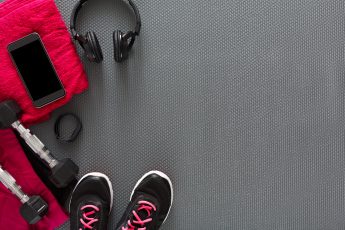
When I began my own fitness journey I made a lot of mistakes and one of them was not writing down how everything started. I’m talking more about measurements, goals, workouts and less about the emotions here. A fitness journal is like a diary but for fitness related information. Below, you’ll find a few tips on how to start writing your journal, why you should do it and how you can measure yourself.
- Getting a journal
You can choose whatever you prefer. A journal can be a beautiful designed paper journal or a simpler version on your computer. Choose something that fits your character and might even inspire you to look and work with daily – which is super important for your future progress. I would highly recommend taking a “before” picture from front, side and back in a bikini and add them into your journal. During your journey you might feel stuck at some point, looking at pictures and changes which have already happened might be a real motivation to keep going and trusting the process. - Start
Now, that you have decided what kind of journal you would like to use we can start. Start by taking pictures (as mentioned above) and taking measurements. I would recommend writing down your current weight and height along with the following measurements:
Bust: Measure all the way around your bust and back on the line of your nipples.
Chest: Measure directly under your breasts, as high up as possible.
Waist: Measure at its narrowest point width-wise, usually just above the navel.
Hips: Measure around the widest part of the hipbones.
Thighs: Measure around fullest part of upper leg while standing
Calves: Measure around fullest part.
Upper arm: Measure above your elbows – around fullest part.
Calculate and write down your BMI (Body mass index): BMI = Weight (kg)/Height (m2) Please keep in mind that a healthy BMI should be higher than 18.5 and lower than 25.
- Define your fitness goals
The next step will be writing down short term, mid term and long term goals. I recommend using the SMART formula:
S– Specific (Clearly defined so anyone can understand the intended outcome)
M– Measurable (If a goal is not quantifiable, you can probably not manage it)
A– Attainable (Challenging, but not too extreme)
R– Realistic (Must be something you are willing and able to work to)
T– Timely (Specific date of completion; realistic but not too far in the future)
It is important to be honest. Set realistic goals and allow yourself time to achieve these goals. If one of your goals might be loosing weight try to aim for 1 to 2 pounds of bodyweight per week. - Define how to achieve your goals
Think about how you can achieve your goals. What is realistic and what can you really incorporate in your schedule? What kind of workouts would you like to do? Do you need a gym membership? Do you need additional help or support?
I would also recommend thinking about working together with a Personal Trainer who can help you even more. - Add an exercise diary into your journal
Note the name of your exercises that you do, followed by the amount of reps, times, and sets – if strength training is your preferred workout method, note weights as well.
- Add your meals into it
Working out and moving more is one point of a lifestyle change. To reach your goal you should keep an eye on your nutrition side as well. Start writing down tour meals, for example: pasta with shrimps and a side salad without dressing but topped with avocado. Keep tracking your drinks too, for example: two sodas, 1 gallon of water and one glass of red wine on Monday. Be honest and take it serious. If you do have a background in nutrition I would suggest keeping it more detailed. List the days of the week, times of the day and relevant information about carbohydrates, proteins and fats as well as your water intake. Make sure you include sugary beverages and sweets as well – even though you might not be happy of how much you really consumed. Do not lie to yourself. - Review your journal every Sunday
Take a moment on every Sunday evening and re-read your goals and why you decided to start your new chapter. Try to identify things that aren’t working for you and things that may need to be adjusted or changed. Review your journal once a week, preferable on your off-gym (recovery day). Take a few minutes to review the past week and take notes about your feelings and positive as well as negative changes you have experienced during the past week.










Leave a Comment